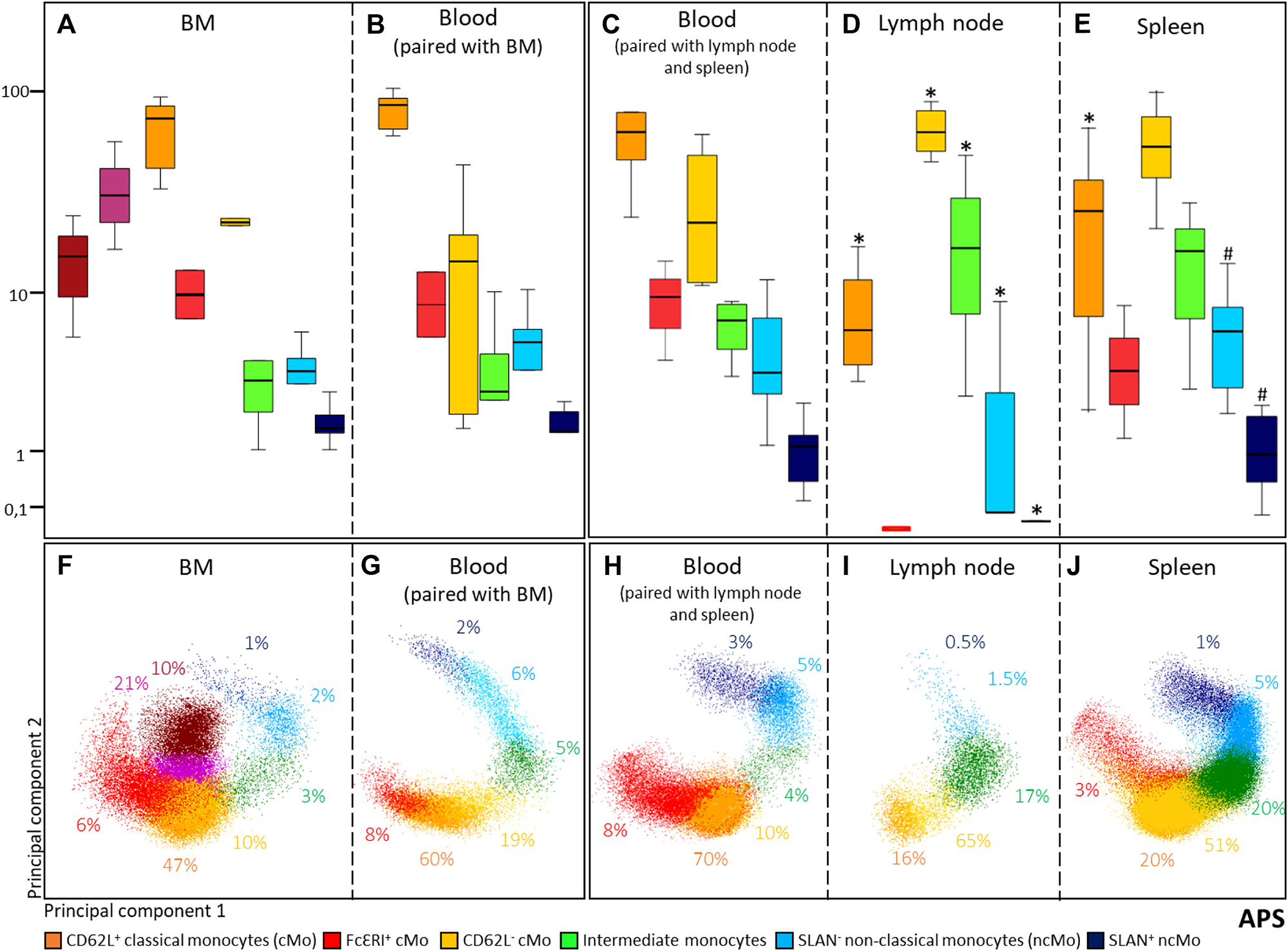Achievements
Results
A major achievement of the TiMaScan project is the development of an antibody panel for detection of different subsets of monocytes by flow cytometry. This antibody panel was used to show that in humans, the numbers of different monocyte subsets, including classical, intermediate and non-classical monocytes, differ depending on age and tissue (Figure 1; Damasceno et al., 2019).

Furthermore, by monitoring different subsets of monocytes in peripheral blood following controlled tissue damage (total hip arthroplasty), we showed that changes in numbers of classical monocytes, which followed the same temporal pattern as total monocytes, are different from the changes in numbers of non-classical monocytes (Figure 2; Van den Bossche et al., 2018).

A patent that covers the detection of monocyte subsets to monitor disruption of tissue homeostasis was filed and granted, and has been licensed to Cytognos.
Publications
- van der Pan K, de Bruin-Versteeg S, Damasceno D, Hernández-Delgado A, van der Sluijs-Gelling AJ, van den Bossche WBL, de Laat IF, Díez P, Naber BAE, Diks AM, Berkowska MA, de Mooij B, Groenland RJ, de Bie FJ, Khatri I, Kassem S, de Jager AL, Louis A, Almeida J, van Gaans-van den Brink JAM, Barkoff AM, He Q, Ferwerda G, Versteegen P, Berbers GAM, Orfao A, van Dongen JJM, Teodosio C. Development of a standardized and validated flow cytometry approach for monitoring of innate myeloid immune cells in human blood. Front Immunol 2022; 13:935879.
- van der Pan K, Kassem S, Khatri I, de Ru AH, Janssen GMC, Tjokrodirijo RTN, Al Makindji F, Stavrakaki E, de Jager AL, Naber BAE, de Laat IF, Louis A, van den Bossche WBL, Vogelezang LB, Balvers RK, Lamfers MLM, van Veelen PA, Orfao A, van Dongen JJM, Teodosio C, Díez P. Quantitative proteomics of small numbers of closely-related cells: Selection of the optimal method for a clinical setting. Front Med 2022; 9:997305.
- Kassem S, van der Pan K, de Jager AL, Naber BAE, de Laat IF, Louis A, van Dongen JJM, Teodosio C, Díez P. Proteomics for low cell numbers: How to optimize the sample preparation workflow for mass spectrometry analysis. J Proteome Res 2021; 20:4217-4230.
- Damasceno D, Teodosio C, van den Bossche WBL, Perez-Andres M, Arriba-Méndez S, Muñoz-Bellvis L, Romero A, Blanco JF, Remesal A, Puig N, Matarraz S, Vicente-Villardón JL, van Dongen JJM, Almeida J, Orfao A; TiMaScan Study Group. Distribution of subsets of blood monocytic cells throughout life. J Allergy Clin Immunol 2019; 144:320-323.e6
- Van den Bossche WBL, Rykov K, Teodosio C, Ten Have BLEF, Knobben BAS, Sietsma MS, Josiassen K, de Bruin-Versteeg S, Orfao A, van Dongen JJM, van Raay JJAM. Flow cytometric assessment of leukocyte kinetics for the monitoring of tissue damage. Clin Immunol 2018; 197:224-230
- Van den Bossche WBL, Kleijn A, Teunissen CE, Voerman JSA, Teodosio C, Noske DP, van Dongen JJM, Dirven CMF, Lamfers MLM. Oncolytic virotherapy in glioblastoma patients induces a tumor macrophage phenotypic shift leading to an altered glioblastoma microenvironment. Neuro Oncol 2018; 20:1494-1504
Other dissemination
- Assessment of methods for lysosome fraction enrichment: an approach for lysosomal MS-based studies. A.L. de Jager. Presentation at Immunology Science Retreat, 30 September 2022, Leiden, The Netherlands.
- Mass spectrometry analysis of highly purified human colon epithelial and stem cell populations in normal colon and colorectal cancer. A.L. de Jager. Poster at Summer School Advanced Proteomics, 1-5 August 2022, Brixen, Italy.
- Quantity-limited maturational-related cells: How to perform reliable proteomics profiling in a medical-oriented setting. K. van der Pan. Presentation at Nederlands Proteomics Platform meeting, 24 May 2022, Utrecht, The Netherlands.
- Quantitative proteomic landscape of quantity-limited human monocytes and glioma macrophages. K. van der Pan. Poster at Science Retreat of Department of Immunology, 21 November 2021, Leiden, The Netherlands.
- Characterizing lysosomal proteases to design an in silico post-digestion peptide prediction tool. A.L. de Jager. Poster at BSPR Interact, 6-8 July 2021, Online.
- Dissection of the monocyte & dendritic cell compartment in blood and bone marrow. K. van der Pan. Presentation at 8th ESLHO Symposium, 7 November 2019, Ghent, Belgium.
- Development of a 14-color flow cytometry tube for standardized identification of innate myeloid cells in human peripheral blood. K. van der Pan. Poster at Keystone Symposium Myeloid Cells, 24-28 February 2019, Santa Fe, USA.
- Dissection of the monocyte-macrophage maturation pathway - as an immune monitoring tool. K. van der Pan. Presentation at Science Retreat of Department of Immunology, 31 May 2018, Leiden, The Netherlands.
- Zoeklicht op het immuunsysteem. Ziekten.nl, 7 January 2018.
- 2,5 Miljoen voor een ‘wild’ idee. Oncologie.nu, 3 August 2016.
- Kanker opsporen via de ‘vuilniswagens’ van het afweersysteem. Press release LUMC, 18 April 2016.
TiMaScan project progress meetings
- 15th TiMaScan meeting, 1-2 July 2019, Salamanca, Spain
- 14th TiMaScan meeting, 22-23 November 2018, Leiden, The Netherlands
- 13th TiMaScan meeting, 30-31 May 2018, Leiden, The Netherlands
- 12th TiMaScan meeting, 29-30 August 2017, Salamanca, Spain
- 11th TiMaScan meeting, 14-15 February 2017, Leiden, The Netherlands
- 10th TiMaScan meeting, 19-20 November 2016, Salamanca, Spain